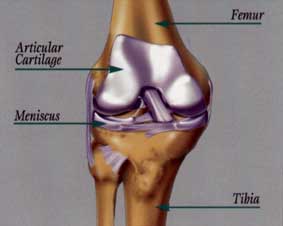HOME
Medical Topics:
Ligament
Injury
Disease
About The Doctor:
Questions?
Email at:
GNYaco@aol.com
| MENISCUS |  |
that acts as a shock absorber in the knee joint. There is one
meniscus on each side of the joint...medial and lateral. Each
meniscus is flat and C-shaped, partially enclosing the
surface on the tibia to deepen it and thereby add stability to
the knee. The surface area for contact between the femur and
the tibia is greatly increased by each menicus. This protects
the articular cartilage covering on the bones by keeping the
contact pressure to a minimum.
2. Injury: A torn meniscus can occur from a
single injury or from
years of
wear and tear. The typical injury is when the knee is
twisted
or angulated under load. If the meniscus
is already
weak from
aging, simple squats can cause a tear. Once torn,
the function
of that part of the meniscus is lost, and pain
and swelling
ensues.
3. Treatment: Simply stated, there is
only one way to treat a torn
meniscus...surgery.
Fortunately, we now have arthroscopic
technology
available which allows us to perform the
operation
through two tiny punctures. One portal is used for
a small
telescope (arthroscope), the other is used for tiny
instruments.
The tear in the meniscus usually produces an
unstable
flap of tissue which must be removed. Some tears,
particularly
in younger patients, can be repaired, thereby
saving
this vital tissue and preserving its function. The
surgery
lasts from 30 to 60 minutes and is performed as an
outpatient
procedure. Rehabilitation begins almost
immediately
and full recovery occurs at about 4 weeks.
If more
than half the meniscus is removed, its function is
lost...and
articular cartilage degeneration will occur in that
part of
the knee. This may begin to cause pain
within 2 to 5
years.
MENISCUS TRANSPLANTATION is a procedure
where a
meniscus from a human tissue bank is surgically
placed
into a knee that is undergoing this degeneration. This
is a fairly
new operation with about 10 years of follow-up.
The patient
experiences relief of pain and increases his/her
activity
in over 855 of the cases studied. It is our hope that
this procedure
will delay or prevent the onset of articular
cartilage
degeneration and destruction of the joint.



Dr. Yacobucci
has had special training in meniscus
transplantation
surgery and has performed over 80 of these
operations.
He is currently participating in clinical research
to evaluate
the longterm results of this procedure.
Back to the Top